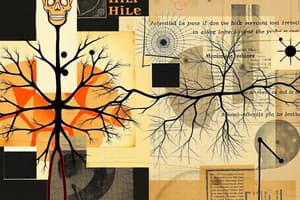Podcast
Questions and Answers
What is the main reason why a small dose of acetylcholine does not affect heart rate?
What is the main reason why a small dose of acetylcholine does not affect heart rate?
- Acetylcholine primarily targets nicotinic receptors in the heart, which are less sensitive to acetylcholine than those in blood vessels.
- Acetylcholine primarily targets muscarinic receptors in blood vessels, which are more sensitive to acetylcholine than those in the heart. (correct)
- Acetylcholine primarily targets nicotinic receptors in blood vessels, which are more sensitive to acetylcholine than those in the heart.
- Acetylcholine primarily targets muscarinic receptors in the heart, which are less sensitive to acetylcholine than those in blood vessels.
Which of the following accurately describes the effect of parasympathetic nerve stimulation on blood pressure and heart rate?
Which of the following accurately describes the effect of parasympathetic nerve stimulation on blood pressure and heart rate?
- Increase in blood pressure, increase in heart rate, decrease in pulse pressure.
- Decrease in blood pressure, decrease in heart rate, decrease in pulse pressure. (correct)
- Increase in blood pressure, increase in heart rate, increase in pulse pressure.
- Decrease in blood pressure, decrease in heart rate, increase in pulse pressure.
What is the primary reason for the decrease in blood pressure during vagal nerve stimulation?
What is the primary reason for the decrease in blood pressure during vagal nerve stimulation?
- Decreased heart rate. (correct)
- Direct innervation of blood vessels by the vagus nerve.
- Release of adrenaline from the adrenal glands.
- Increased contractility of the heart.
What is the role of the Langendorff apparatus in this experiment?
What is the role of the Langendorff apparatus in this experiment?
Why does an increase in the interval between heartbeats lead to a greater pulse pressure?
Why does an increase in the interval between heartbeats lead to a greater pulse pressure?
What neurotransmitter is released from the post-ganglionic nerve fibers to stimulate the heart?
What neurotransmitter is released from the post-ganglionic nerve fibers to stimulate the heart?
Which receptor on the heart is responsible for the effects of noradrenaline?
Which receptor on the heart is responsible for the effects of noradrenaline?
What is the effect of β1 receptor activation on the heart?
What is the effect of β1 receptor activation on the heart?
Flashcards
Langendorff apparatus
Langendorff apparatus
Device used to study the heart's physiology by perfusing it with a fluid while controlling conditions.
Pulse pressure
Pulse pressure
The difference between systolic and diastolic blood pressures, indicating heart's stroke volume.
Effect of parasympathetic stimulation on heart rate
Effect of parasympathetic stimulation on heart rate
Parasympathetic activation leads to decreased heart rate and blood pressure.
Acetylcholine's effect on blood vessels
Acetylcholine's effect on blood vessels
Signup and view all the flashcards
Vagal nerve stimulation effect
Vagal nerve stimulation effect
Signup and view all the flashcards
Noradrenaline transmitter
Noradrenaline transmitter
Signup and view all the flashcards
β1 receptor role
β1 receptor role
Signup and view all the flashcards
Acetylcholine and M2/M3 receptors
Acetylcholine and M2/M3 receptors
Signup and view all the flashcards
Study Notes
Pharmacology 2 Lab 1: SNS and PSNS Effect on Blood Pressure and Heart Rate
- The lab investigates the effects of the sympathetic (SNS) and parasympathetic (PSNS) nervous systems on blood pressure and heart rate.
- The SNS and PSNS use different neurotransmitters to have opposing effects on bodily functions including heart rate and blood pressure.
- Anatomy of the vagus and cardiac nerves are crucial to understand the underlying mechanisms.
- The Langendorff apparatus (shown in diagrams) is used to isolate and perfuse the heart. This allows researchers to monitor the heart's response to various stimuli in a controlled environment.
Autonomic Nervous System Effects on Blood Pressure and Heart Rate
- The parasympathetic nervous system (PSNS) slows down the heart rate and lowers blood pressure.
- Parasympathetic nerve stimulation, often using the vagus nerve, produces a fall in blood pressure, primarily due to a reduction in heart rate.
- The neurotransmitter released by the postganglionic nerve is acetylcholine, stimulating muscarinic and nicotinic receptors.
- The sympathetic nervous system (SNS) accelerates heart rate and elevates blood pressure.
- The neurotransmitter released by the postganglionic nerve following sympathetic stimulation is noradrenaline, activating beta-1 adrenergic receptors, leading to an increase in heart rate and blood pressure.
- A small dose of acetylcholine selectively dilates arterioles.
Laboratory Methods
- In experiments, a pair of needle electrodes is used to record cardiac activity from the superior cardiac branch while cranial to the cervical Vagus Nerve (VN), which acts as a control.
- Blood pressure and heart rate are monitored and measured over time, with different doses of neurotransmitters (e.g., acetylcholine and noradrenaline) being given to assess the physiological responses.
Summary of Parasympathetic Effects
- Low doses of acetylcholine cause a drop in peripheral resistance and blood pressure, without significant changes in heart rate. This is related to peripheral arteriolar vasodilation which reduces blood pressure.
- High doses of acetylcholine cause a fall in both peripheral resistance and the heart rate.
Summary of Sympathetic Effects
- Small doses of noradrenaline mainly increase diastolic blood pressure but have minimal effect on heart rate.
- Noradrenaline's actions are mediated through alpha and beta-1 adrenergic receptors, primarily causing constriction in arterioles.
- High doses of noradrenaline increase both peripheral resistance and cardiac output. This results in a greater increase in blood pressure than seen following low-dose stimulation.
- Adrenaline and noradrenaline have differing effects on blood pressure; higher concentrations of adrenaline have a greater effect on heart rate.
Additional Information
- Most muscarinic receptors on blood vessels lack any direct innervation.
- Muscarinic receptors present on blood vessels in the brain, buccal cavity, and genitals receive parasympathetic innervation.
- Muscarinic receptors present on blood vessels in skeletal muscle are innervated by sympathetic nerves (cholinergic nerves).
Studying That Suits You
Use AI to generate personalized quizzes and flashcards to suit your learning preferences.



